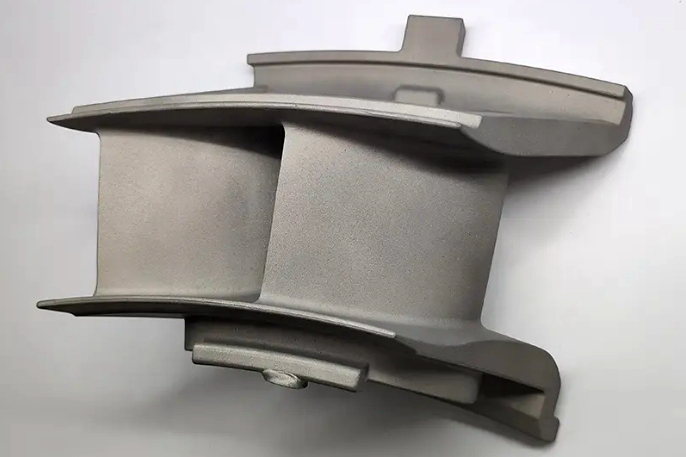Superalloy Nimonic 80A Guide Vanes Equiaxed Crystal Casting Supplier
Introduction
Nimonic 80A is a nickel-chromium alloy strengthened with titanium and aluminum, offering excellent high-temperature strength, oxidation resistance, and creep resistance up to 815°C. With a tensile strength around 950 MPa and superb fatigue resistance, it is ideal for guide vanes operating in high-load, high-temperature gas turbine environments.
At Neway AeroTech, we supply Nimonic 80A guide vanes using advanced equiaxed crystal vacuum investment casting technology, ensuring fine-grain structure, precise dimensional accuracy, and enhanced mechanical performance for aerospace and industrial turbine applications.
Key Manufacturing Challenges for Nimonic 80A Guide Vanes
Controlling solidification rates (~5–8°C/min) to form uniform equiaxed grains for creep strength.
Maintaining chemical composition (Ni ≥69%, Cr ~20%, Ti ~2.4%, Al ~1.4%) for maximum oxidation and fatigue resistance.
Achieving tight dimensional tolerances (±0.05 mm) for aerodynamic performance and assembly fit.
Ensuring superior surface finishes (Ra ≤1.6 µm) to reduce turbulence and optimize airflow.
Equiaxed Crystal Casting Process for Nimonic 80A Guide Vanes
The production process involves:
Wax Pattern Fabrication: Precision wax models with ±0.1% dimensional accuracy.
Ceramic Shell Formation: Multiple layers of ceramic slurry and refractory sands for high shell strength.
Dewaxing: Autoclaving at ~150°C to remove wax while preserving shell integrity cleanly.
Vacuum Melting and Pouring: Alloy melted at ~1380°C and poured under vacuum (<10⁻³ Pa) to avoid oxidation.
Controlled Solidification: Uniform cooling to form fine equiaxed grains, enhancing creep and fatigue resistance.
Shell Removal and Final Finishing: Ceramic shell removal, CNC machining, and polishing to meet final specifications.
Comparative Analysis of Casting Methods for Guide Vanes
Process | Surface Finish Quality | Dimensional Precision | Mechanical Strength | Creep Resistance | Cost Level |
|---|---|---|---|---|---|
Equiaxed Crystal Casting | Good (Ra ~3 µm) | High (±0.05 mm) | Excellent (~950 MPa) | High | Moderate |
Single Crystal Casting | Excellent (Ra ≤1.6 µm) | Very High (±0.03 mm) | Superior | Superior | High |
Sand Casting | Moderate (Ra ~12 µm) | Moderate (±0.5 mm) | Good (~800 MPa) | Moderate | Low |
CNC Machining from Billet | Excellent (Ra ≤0.8 µm) | Very High (±0.01 mm) | Excellent | Excellent | High |
Optimal Manufacturing Strategy for Nimonic 80A Guide Vanes
Equiaxed crystal casting: Preferred for cost-effective production with strong high-temperature mechanical properties.
Single crystal casting: Used for extreme high-load applications needing maximum creep resistance.
Sand casting: Limited to non-critical, low-stress guide vane applications.
CNC machining: Reserved for achieving ultra-high precision secondary finishing.
Nimonic 80A Alloy Performance Overview
Property | Value | Application Relevance |
|---|---|---|
Tensile Strength | ~950 MPa | Excellent strength for turbine environments |
Max Operating Temperature | ~815°C | Reliable mechanical performance in turbine service |
Fatigue Resistance | Superior | Resists cracking under cyclic loading |
Oxidation Resistance | Excellent | Withstands aggressive exhaust gas environments |
Thermal Expansion Coefficient | ~13.5 µm/m·°C | Maintains dimensional stability under heat cycling |
Advantages of Using Nimonic 80A for Guide Vanes
High tensile and fatigue strength ensures vane durability in high-speed turbine environments.
Outstanding oxidation resistance minimizes degradation at 815°C service temperatures.
Excellent creep resistance ensures vane geometry stability under continuous thermal and mechanical stress.
Good formability and castability enable complex aerodynamic designs.
Post-processing Techniques for Nimonic 80A Vanes
Hot Isostatic Pressing (HIP): Densifies material, eliminating internal porosity at ~1160°C, 100 MPa.
Thermal Barrier Coating (TBC): Applies ~250 µm ceramic coating to enhance thermal fatigue life.
Precision CNC Machining: Achieves ±0.01 mm tolerances for aerodynamic surfaces.
Non-destructive Testing (NDT): Validates defect-free internal and external structures.
Inspection and Quality Assurance for Guide Vanes
Coordinate Measuring Machine (CMM): Ensures ±0.05 mm dimensional precision on critical aerodynamic surfaces.
Ultrasonic Testing (UT): Detects internal flaws without affecting part integrity.
Dye Penetrant Testing (PT): Locates surface defects down to 0.002 mm width.
Metallographic Analysis: Confirms microstructure and grain size compliance with ASTM standards.
Industry Applications and Case Study
Nimonic 80A guide vanes produced by Neway AeroTech are widely used in aerospace turbines, industrial gas turbines, and high-performance energy generation systems. In a leading aerospace turbine project, equiaxed cast Nimonic 80A vanes maintained dimensional stability and strength over 7,000 operational hours, reducing maintenance frequency and extending engine overhaul intervals by 20%.
FAQs
What dimensional tolerances does Neway AeroTech achieve for Nimonic 80A guide vanes?
Why is equiaxed crystal casting suitable for Nimonic 80A vane production?
How does Nimonic 80A compare to other Nimonic alloys in turbine service?
What industries commonly use Nimonic 80A guide vanes?
How does Neway AeroTech ensure the quality of Nimonic 80A cast vane components?

